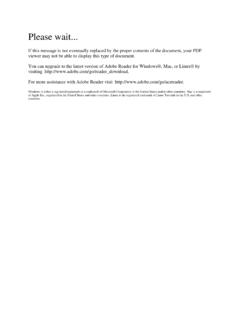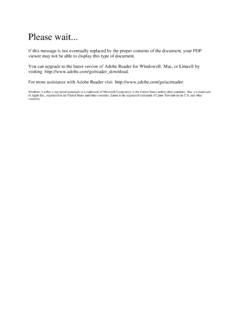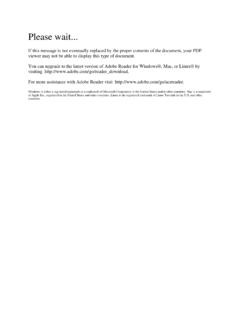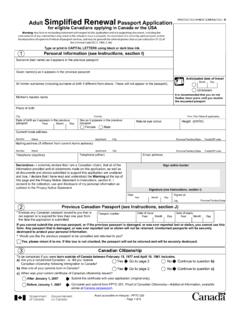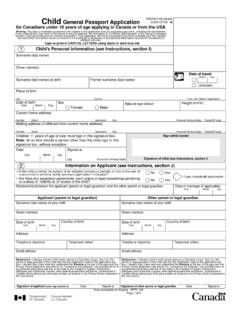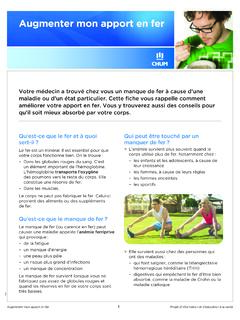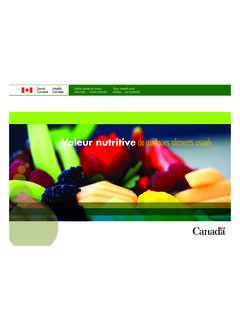Transcription of Nutrient Value of Some Common Foods - Canada
1 Nutrient Value of Some Common Foods 1 3/5/2008 12:36:28 AM. Nutrient Value of Some Common Foods Nutrient Value of Some Common Foods Health Canada is the federal department responsible for helping Canadians maintain and improve their health. We assess the safety of drugs and many consumer products, help improve the safety of food, and provide information to Canadians to help them make healthy decisions. We provide health services to First Nations people and to Inuit communities. We work with the provinces to ensure our health care system serves the needs of Canadians. Published by authority of the Minister of Health. Nutrient Value of Some Common Foods is available on Internet at the following address: galement disponible en fran ais sous le titre : Valeur nutritive de quelques aliments usuels This publication can be made available by request on diskette, large print, audio-cassette and braille. For further information or to obtain additional copies, please contact: Publications Health Canada Ottawa, Ontario K1A 0K9.
2 Tel.: (613) 954-5995 or 1-866-225-0709. Fax: (613) 941-5366. E-Mail: Her Majesty the Queen in Right of Canada , represented by the Minister of Health Canada , 2008. Require permission at all times HC Pub.: 4771. Cat.: H164-49/2008E-PDF. ISBN: 978-0-662-48082-2. 1. 1 3/5/2008 12:36:54 AM. Nutrient Value of Some Common Foods Introduction As Canadians recognize the crucial role of nutrition in the maintenance of good health, they increasingly seek information regarding the Nutrient density of Foods on the Canadian market. Health Canada publishes two databases which list Nutrient values in Canadian Foods . The first is a large, comprehensive, computer- ized database called the Canadian Nutrient File (CNF). The 2007b version reports up to 143 nutrients in 5516 Foods . The CNF can be accessed on the Internet at While this format and detail are useful to health professionals and food industry personnel, a second abbreviated, printed version is a more practical reference for many Canadians.
3 For this reason we have produced this booklet entitled Nutrient Value of Some Common Foods . This publication lists the nutrients most relevant in terms of public health and contribution to the food supply of 1100 of the most commonly consumed Foods in Canada . Nutrient values taken from the CNF are calculated in terms of reasonable average household measures of the ready-to-eat form of the food. These amounts are not always identical to the serving sizes displayed on Canada 's Food Guide, which are deter- mined for the purpose of providing healthy patterns of eating for a wide range of ages and gender. i Sec1:i 3/5/2008 12:36:54 AM. Nutrient Value of Some Common Foods Contents Facts About the Foods 1. Facts About the Nutrients 2. Nutrients and Other Components 3. Abbreviations and Symbols 3. Index 57. Breads, Cereals and Other Grain Products 4. Flours and Brans 4. Breads and Buns 4. Other Bread Products 5.
4 Pancakes, Waffles and French Toast 5. Rice, Pasta and Other Grains 6. Breakfast Cereals 7. Crackers 8. Baked Goods 10. Biscuits, Croissants and Muffins 10. Cookies, Granola Bars and Other Bars 10. Cakes 11. Pies 12. Other Baked Goods 13. Vegetables and Vegetable Products 14. Vegetables 14. Vegetable Juices and Other Products 17. Fruit and Fruit Juices 19. Fruit 19. Fruit Juices 21. Dairy Foods and Other Related Products 22. Milk and Substitutes 22. Processed Milk 22. Milk Beverages 23. Yogourts and Fermented Milk Products 23. ii Sec1:ii 3/5/2008 12:36:55 AM. Cheese 23. Cream 24. Imitation Cream Products 25. Pudding 25. Eggs and Egg Dishes 26. Fish and Shellfish 27. Fish 27. Shellfish 28. Fish Products 29. Meat and Poultry 30. Beef 30. Veal 31. Pork 31. Lamb 32. Poultry and Game Birds 32. Game Meats and Other Meats 33. Liver and Organ Meats 33. Processed Meat Products 34. Legumes, Nuts and Seeds 36.
5 Meatless Products 36. Beans, Peas and Lentils 36. Peanuts 37. Nuts 37. Nut Butters 37. Seeds 38. Fast Foods 39. Beverages 39. Side Dishes 39. Sandwiches 39. Chinese 40. Pizza 40. Other 40. Mixed Dishes 41. Mexican 41. Sandwiches 41. iii Sec1:iii 3/5/2008 12:36:55 AM. Salads 41. Pasta 41. Other 42. Soups 43. Ready-to-serve 43. Condensed, prepared with water 43. Condensed, prepared with 2% milk 43. Dehydrated, prepared with water 44. Homemade 44. Fats and Oils 45. Butter and Margarine 45. Oils 45. Other 45. Salad Dressings 46. Sweets and Sugars 47. Sugar, Honey and Substitutes 47. Syrup and Molasses 47. Preserves 47. Toppings and Spreads 47. Candies 48. Chocolate Bars 48. Frozen Desserts 49. Other Desserts 50. Snacks 51. Popcorn 51. Chips 51. Other Snacks 51. Beverages 52. Coffee, Tea and Substitutes 52. Carbonated Drinks 52. Fruit-Flavoured Drinks 53. Other Beverages 53. Alcoholic 53. Miscellaneous 55.
6 Condiments 55. Dips 55. Gravies and Sauces 55. iv Sec1:iv 3/5/2008 12:36:55 AM. Nutrient Value of Some Common Foods Facts About the Foods This edition of the Nutrient Value of Some Common Foods is an update to the 1999 version. During this interval, changes have taken place in the food supply, in our understanding of nutrition with regards to health and disease prevention, and to nutrition recommen- dations. In this updated version of the Nutrient Value of Some Common Foods , the emphasis has been placed on mixed dishes rather than individual ingredients. Detailed ingredient information is available on the CNF website. Common recipes have been used to calculate Nutrient profiles of mixed dishes. As there are multiple variations possible for recipes and ingredients, values given may not precisely match the profile of food you consume. For example, a lasagna prepared with veal and white sauce would differ somewhat from one prepared with the more Common ground beef and tomato sauce.
7 Please use these recipes as a general reference not a specific match to what you are eating. Users may find some Foods have been re-categorized, to better allow comparison between similar Foods . For this reason, Foods found in some categories will not match those displayed in Canada 's Food Guide. Foods commonly consumed by Canadians have been chosen and listed alphabetically under 17 general food headings. This classifi- cation allows the user to easily locate a particular food and to compare its Nutrient values to similar Foods . The index should be used to locate Foods whose classification may not be apparent. Products such as infant formulas, baby Foods and frozen dinners are not included. Nutrient values for these products are well docu- mented by the manufacturers, and can be found on the labels. Nutrient values are given for the weight of the edible portion as described. This is the portion remaining after inedible or refuse parts are discarded, and cooking losses are calculated.
8 This is especially important to note in the meat groupings, where descriptive mea- sure and nutrients are for the cooked product unless raw is specifically stated in the food name. Because of the condensed version of this booklet, composites have been used in several categories. These composites are an aver- aging of the most Common cuts or brands. The resulting Nutrient profiles give approximate values that can be used if a more precise match cannot be found. 1. Sec2:1 3/5/2008 12:36:55 AM. Nutrient Value of Some Common Foods Facts About the Nutrients The approach to choosing nutrients for inclusion in the booklet has changed. The set of 19 nutrients now varies for different food groupings. Nutrients relevant to one specific food group may not be as important to another. For example, cholesterol is present in meats but is not present in fruits and vegetables. When nutrients do not contribute significantly, emphasis is now directed towards components more specific to the group.
9 This allows the addition of more detailed information on the types of fats in the fats and oils group, reporting of beta-carotene and lycopene in the fruit and vegetable groups, and inclusion of values for alcohol and caffeine in the beverage group. Although trans fatty acids are of public interest, these values cannot be included in this publication. Most food values in the CNF and therefore in this booklet, are generic. For example, chocolate cookies are a representative average of the most popular selling brands in Canada and do not correspond to a specific brand name. The fatty acid content of individual brands can vary widely, and many companies are in the process of re-formulating due to consumer demand. For these reasons, the most reliable way to determine trans fat content of your pre-packaged food is to check the mandatory Nutrition Facts table found on the package. Trace indicates a measurable quantity in the food, but too small to be included.
10 Zeros indicate a true zero content of the Nutrient . N/A. indicates a lack of data or missing Value for a Nutrient . Do not assume that missing values are zeros. The values presented are mean values for a nationwide representative sample. Some of them have a wide range of deviation based on a variation in contributing samples due to such factors as soil type, season, geography, genetics and diet. DHA and EPA (docosahexanoic acid and eicosapentanoic acid) are long chain omega-3 fatty acids that are known to have positive effects on health. The major dietary source of these fatty acids is fatty fish. Vitamin E is the Common name for the family of antioxidants called tocopherols. Nutrition recommendations are based solely on alpha-tocopherol as this naturally occurring form is the most biologically active. Vitamin E in this booklet refers to alpha-tocopherols only. 2. Sec2:2 3/5/2008 12:36:56 AM. Nutrients and Other Components Nutrient Unit of measure Nutrient Unit of measure Energy kcal Folate mcg DFE.
